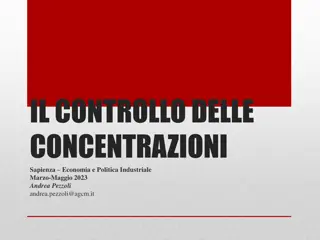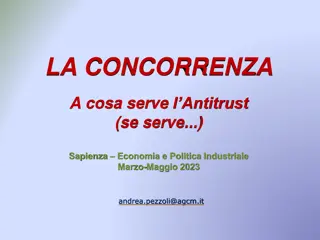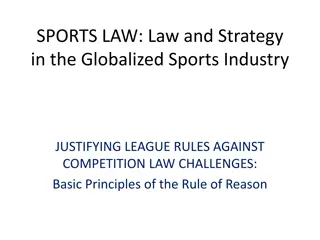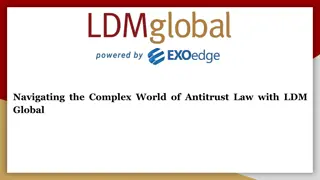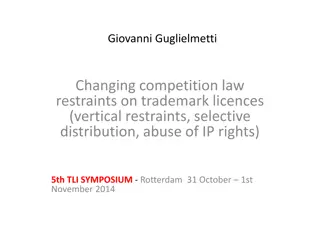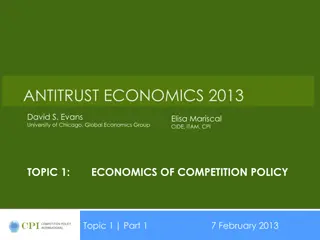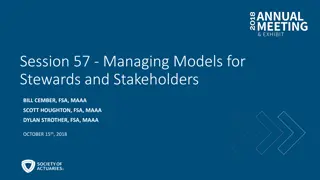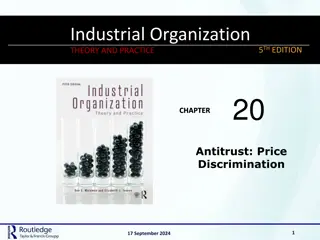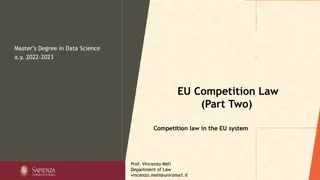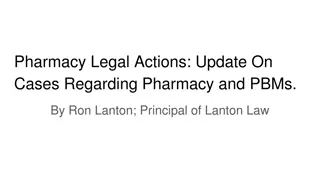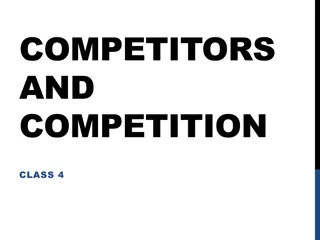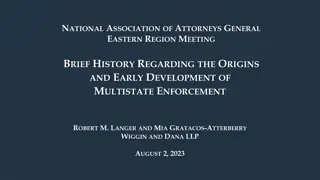Understanding Antitrust Laws: Market Definition and Power Analysis
The economic purpose of antitrust laws is to ensure overall economic efficiency by focusing on whether a practice benefits or harms consumers. Antitrust cases involve defining relevant markets and assessing market power, distinguishing between market power and monopoly power. Understanding these concepts is crucial for analyzing anticompetitive effects and potential mergers.
Uploaded on Sep 15, 2024 | 0 Views
Download Presentation

Please find below an Image/Link to download the presentation.
The content on the website is provided AS IS for your information and personal use only. It may not be sold, licensed, or shared on other websites without obtaining consent from the author. Download presentation by click this link. If you encounter any issues during the download, it is possible that the publisher has removed the file from their server.
E N D
Presentation Transcript
MARKET DEFINITION, MARKET POWER, AND COMPETITIVE EFFECTS Antitrust Boot Camp Loyola University Chicago School of Law July 16-17, 2019 Alan S. Frankel President, Coherent Economics and Adjunct Professor, Loyola University Chicago School of Law COHERENTECON.COM 9/15/2024 1
WHAT IS THE ECONOMIC PURPOSE OF ANTITRUST LAWS? Two Schools of Thought: Consumer welfare standard does the challenged conduct increase or decrease the aggregate benefits to consumers of the product or service? Total welfare standard does the challenged conduct increase or decrease the aggregate benefits to the combined benefits obtained by both consumers and producers of the product or service? Focus on overall economic efficiency. If a practice harms consumers but profits increase by more than consumers are harmed, the practice should be permitted. In general, the consumer welfare standard seems to prevail. But many defenses are offered for conduct that has anticompetitive effects; sometimes these involve benefits to sellers.. Primary economic question: did/does/will the conduct benefit or harm consumers? Or, the public at large ( society ). COHERENTECON.COM 9/15/2024 2
1. Market definition and market power: an overview 2. The Hypothetical Monopolist Test TOPICS 3. Mergers vs. Non-Merger Contexts 4. Anticompetitive effects COHERENTECON.COM 9/15/2024 3
MARKET DEFINITION Courts expect or require plaintiff to define relevant market in rule of reason antitrust cases. Not necessary in per se cases such as price fixing, bid rigging, market allocation. Why per se? Benefits from conduct are considered so rare or unlikely as to not warrant deeper investigation. But not uncommon in follow-on civil litigation for damages relating to overcharges. Market definition has a product dimension and a geographic dimension. Economists sometimes find a requirement to define a market annoying. Market definition may involve reducing complex economic relationships to a simplistic label. Defining markets often eliminates rather than adds economic information and insights. Defining markets is typically less useful (to economists) in non-merger contexts. Why define a market? Part of an indirect analysis of the extent of a defendant s actual or potential market power. COHERENTECON.COM 9/15/2024 4
MARKET POWER OR MONOPOLY POWER? Supreme Court: Market power: "the ability to raise prices above those that would be charged in a competitive market. Monopoly power: "the power to control prices or exclude competition. DOJ: Precisely where market power becomes so great as to constitute what the law deems to be monopoly power is largely a matter of degree rather than one of kind. Clearly, however, monopoly power requires, at a minimum, a substantial degree of market power. [P]ower in question is generally required to be much more than merely fleeting; that is, it must also be durable. https://www.justice.gov/atr/competition-and-monopoly-single-firm-conduct-under-section-2-sherman-act I will treat them as synonymous, and the distinction arbitrary. Economists might also be vague or arbitrary, focus on significant market power. COHERENTECON.COM 9/15/2024 5
WHY DO WE CARE ABOUT MARKET POWER? Market power is an indicator of a defendant s economic ability to harm the public. Or, in cases involving collective action, possibly defendants joint ability to cause harm. What constitutes economic harm? Higher prices. Reduced output. (Or, e.g., reduced quality, innovation.) Higher prices and reduced output typically are closely linked: Law of Demand: all else equal, consumers buy less when price is higher. OPEC reduces output to increase oil prices. Relevant consumer in antitrust cases can be businesses, including intermediaries that resell. Sometimes anticompetitive conduct by buyers harms sellers (e.g., bid-rigging at auctions). Antitrust typically treats anticompetitive conduct by buyers symmetrically with that of sellers. But there are differences of opinion concerning whether exercise of buyer power is desirable (e.g., WalMart). COHERENTECON.COM 9/15/2024 6
NOT ALL MARKET POWER IS CONSIDERED UNDESIRABLE Distinction between market power achieved through procompetitive vs. anticompetitive means. Anticompetitive, e.g.: Mergers that significantly reduce competition. Cartel conduct. Exclusionary conduct. Procompetitive, e.g.: Efficiencies, cost reductions, superior products, innovation. Sometimes challenged conduct has both anticompetitive and procompetitive effects. Under rule of reason these are balanced, but often one or the other is considered de minimis. The quest for monopoly profits can drive innovation that benefits the public. We protect monopoly profits under intellectual property laws for this reason. But IP rights are limited many antitrust actions flow from claims that IP rights were wrongly asserted. Generally it is a bad idea to sanction firms merely because they were successful. There can be exceptions that justify regulation or market redesign. COHERENTECON.COM 9/15/2024 7
DIRECT EVIDENCE OF MARKET POWER High profits. High prices relative to costs ( price-cost margins ). Low demand elasticity facing the defendant(s). A highly competitive market (high firm elasticity of demand) may have very low market demand elasticity. Example: bottled water on summer day in Las Vegas. Collusion can be tempting if market demand elasticity is low. And more likely if sellers can communicate and coordinate effectively. Determining what constitutes high profits, prices is difficult. A solution sometimes is to examine changes or differences in prices and profits. Before-during-after some alleged anticompetitive conduct. Between products or locations affected and not affected by the conduct. COHERENTECON.COM 9/15/2024 8
INDIRECT EVIDENCE OF MARKET POWER Long tradition in antitrust. Structure-Conduct-Performance Paradigm (originally described by economists in 1933). Hypothesis: Firms with high market shares will be more likely to exercise market power. Firms in highly concentrated markets will be more likely to exercise market power. This requires determination of market shares which requires definition of the relevant market. Indirect, structural evidence of market power involves analysis of, e.g.: Market share(s) of defendant(s). Market concentration. (Modern measure: the HHI.) Supply-side substitution and barriers to entry. Perhaps characteristics of customers and nature of marketplace and transactions. COHERENTECON.COM 9/15/2024 9
MECHANICS OF THE HERFINDAHL-HIRSCHMAN INDEX (HHI) Sum of the squared market shares of each supplier. Example: Firm 1 market share = 40%; squared share = 1600 Firm 2 market share = 30%; squared share = 900 Firm 3 market share = 20%; squared share = 400 Firm 4 market share = 10%; squared share = 100 Sum of shares = 100%; sum of squared shares = 3000 Monopolist (100% share) HHI = 10,000; 10 equal firms: HHI=10 x 100 = 1000 DOJ/FTC Merger Guidelines: HHI below 1500: Unconcentrated HHI between 1500 and 2500: Moderately Concentrated HHI above 2500: Highly Concentrated Not a rigid screen although high levels of concentration do raise concerns. https://www.justice.gov/atr/file/810276/download COHERENTECON.COM 9/15/2024 10
HYPOTHETICAL MONOPOLIST TEST (I) Used to define relevant markets. Designed to aid antitrust analysis of proposed mergers. But often used in other contexts. Important difference between mergers and other antitrust cases: Merger analysis is predictive: will the public be harmed in the future if we let these firms merge? Other cases: Did/does the defendant(s) past/present conduct harm the public? Does the defendant possess market power now? We ll come back to this distinction. COHERENTECON.COM 9/15/2024 11
HYPOTHETICAL MONOPOLIST TEST (II) Start with smallest set of products that include those at issue. I.e., in merger cases, the firms narrow overlapping products. Example: KKR s acquisition of RJR Nabisco had several overlaps, e.g.: Del Monte and Hunts tomato products. Chung King and La Choy prepared Asian food products. Planters and Fisher nuts If relevant market is roasted nuts shares and HHI are high; if market is salty snacks shares and HHI are much lower. Under hypothetical monopolist test (HMT) we start tentatively with a market for nuts. (In theory it is possible for there to be even narrower markets, e.g., peanuts, cashews, mixed nuts, etc.) COHERENTECON.COM 9/15/2024 12
HYPOTHETICAL MONOPOLIST TEST (III) Would a hypothetical monopolist of the narrow market be able to profitably sustain a small but significant, non- transitory increase in price (SSNIP)? If so, the narrow proposed market is in fact a relevant market. If not, this means: Consumer substitution to other products would defeat a price increase. Nearest competing products are added to the proposed market. Analysis is repeated. Process continues until hypothetical monopolist over the set of products can profitably increase prices. That is, until the hypothetical monopolist can exercise market power. COHERENTECON.COM 9/15/2024 13
MARKETS MAY INCLUDE SUBSTITUTES IN DEMAND Question investigated: does the existence of a substitute constrain the pricing of the product? E.g., does the ability of consumers to switch to pretzels prevent a nut monopolist from exercising market power? Supply factors can also be relevant: can pretzel manufacturers quickly enter with a line of nuts? Collections of products or the sale of collections of products can be a relevant market. Supermarkets Office supply superstores Food service distributors Paper clips are not a substitute for pencils. Carrots are not a substitute for milk. But sale of milk by gas stations, carrots by produce stands, likely cannot constrain supermarket monopolist from exercising market power as can competition from other supermarket chains. COHERENTECON.COM 9/15/2024 14
DETERMINATION WHETHER HYPOTHETICAL MONOPOLIST COULD SUCCESSFULLY IMPOSE A SSNIP This can be difficult and disputed. History in marketplace and natural experiments sometimes makes it clear. What happened when there was entry in the past (e.g. patents expired)? Hypothetical example: Drugs A and B have been in use for many years and have many generic equivalents. Drug C is newer but treats same condition as A and B. Upon patent expiration, generic equivalents for C are introduced and price declines significantly. This suggests Drug C is a relevant market: hypothetical monopoly of C would enable restoration of high price. Evidence (documents, testimony, econometrics) on substitution as prices increase. COHERENTECON.COM 9/15/2024 15
HYPOTHETICAL MONOPOLIST TEST IN NON-MERGER CASES (I) Cellophane Merger issue is whether control of both products will enable merged company to exercise market power (or more market power). In non-merger contexts defendant is alleged to already possess (and exercise) market power. Cellophane fallacy Other products were good substitutes only at monopoly price for cellophane, not at the competitive price. Monopolists increase price until they lose significant sales, often as customers switch to alternatives. At competitive price, cellophane had low price elasticity. HMT can sometimes be used, with caveats. COHERENTECON.COM 9/15/2024 16
HYPOTHETICAL MONOPOLIST TEST IN NON-MERGER CASES (II) Credit Cards HMT can be a conservative test for defining the relevant market in a non-merger case. Example: Visa, Mastercard, Amex enforced rules that had allegedly already had anticompetitive effects. Amex: debit cards are in market, Amex share low, no market power. HMT: Debit Cards Hypothetical merger of all credit card operations, so only one firm offers credit cards and serves merchants for credit card transactions. Debit cards still offered by many banks, processed by several networks. Seems obvious that hypothetical monopolist of credit cards could profitably increase fees, reduce rewards. (Probably for same reason, Amex expert avoided HMT. Amex dropped debit argument on appeal, prevailed on two-sided market grounds.) COHERENTECON.COM 9/15/2024 17
HYPOTHETICAL MONOPOLIST TEST IN NON-MERGER CASES (III) In many cases, the monopolist is alleged to be not hypothetical, but actual (or a cartel). In such circumstances economists sometimes question the importance of market definition. Direct evidence of harm to competition (e.g. higher prices) means whatever the extent of the relevant market, it was insufficiently broad to prevent the defendant(s) from exercising market power. Reminder: the reason we define market is to determine if the defendant has market power. The reason we evaluate market power is to determine if the defendant can cause economic harm. But all of this is superfluous if we can establish economic harm directly. Evidence of economic harm can be used to establish market power and market definition. Recall the generic drug C example (alternative to drugs A and B). If we observe significant increase in price for C controlling for cost and notwithstanding continued competition from A and B, this can be evidence of e.g. collusion and the joint exercise of market power. It also is evidence that the relevant market excludes A and B. Often both direct and indirect approaches are used for market power and market definition. COHERENTECON.COM 9/15/2024 18
COMPETITIVE EFFECTS: THE ULTIMATE QUESTION Firms typically are permitted to exercise their unilateral market power. But firms typically may not act collectively to exercise market power. Individual firms with unilateral market power may be prohibited from: Merging with a rival supplier that significantly increases its market power. Unless perhaps efficiencies from merger are substantial and are sure to result in consumer benefits. Undertaking exclusionary actions Undertaking conduct that has collusive-like effects. Economists analyze evidence to determine if conduct causes antitrust injury. Also analyze potential efficiencies or procompetitive effects (potential defense). Also analyze damages, likely competitive effects of proposed injunctions, etc. COHERENTECON.COM 9/15/2024 19
I am happy to answer questions. Email me at alan.frankel@coherentecon.com COHERENTECON.COM 9/15/2024 20



